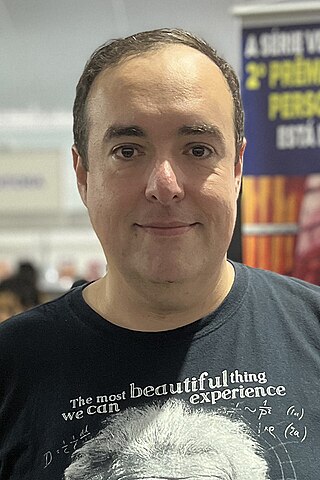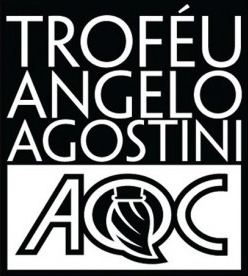
Festival Internacional de Quadrinhos (FIQ) is a comic convention held in Belo Horizonte, Brazil, every two years.

Brazilian comics started in the 19th century, adopting a satirical style known as cartoon, charges or caricature that would later be cemented in the popular comic strips. The publication of magazines dedicated exclusively to comics, in Brazil, started at the beginning of the 20th century. Brazilian artists have worked with both styles. In the case of American comics some have achieved international fame, like Roger Cruz with X-Men and Mike Deodato with Thor, Wonder Woman and others.
Renato Vinícius Canini was a Brazilian illustrator, known for his work in publications like O Pasquim and Pancada, and for Editora Abril, where he drew Disney comics, chiefly José Carioca. He gave the character a more authorial style, and a more Brazilian identity.

Marcello Eduardo Mouco Quintanilha Quintanilha is a Brazilian comic book artist.

André Diniz is a Brazilian comics artist. He began working with comics in 1994 with the fanzine Grandes Enigmas da Humanidade, which had a circulation of 5,000 copies.

Omar Viñole is a Portuguese-born Brazilian comics artist, colorist and inker.
Universo HQ is a Brazilian website about comics and considered the most important Brazilian information source on comics-related news.
Guia dos Quadrinhos is a Brazilian comic book database created with the objective of cataloging all comics published in Brazil, whether graphic novels, magazines, fanzines or independent publications.

Bianca Pinheiro is a Brazilian comics artist and illustrator. She graduated from Graphic Arts by UTFPR and did postgraduate studies in Comics by the Grupo Educacional Opet.

Lucio Luiz is a Brazilian journalist, writer, editor, podcaster and comics author. He holds a degree in Journalism and has Master's degree and Doctorate in Education.

Master of National Comics is one of the categories of Prêmio Angelo Agostini, the most traditional Brazilian award dedicated to comics that has been held since 1985 by Associação dos Quadrinhistas e Caricaturistas do Estado de São Paulo (AQC-ESP).
Flavio Colin was a Brazilian comic artist and illustrator, considered one of the most important comic artists in Brazil. He began his career in the 1950s with an adaptation for the comic book radio series As Aventuras do Anjo, influenced by Milton Caniff, but began to gain prominence with the development of his own stylized artist style. In 1987, he was awarded with the Prêmio Angelo Agostini for Master of National Comics, an award that aims to honor artists who have dedicated themselves to Brazilian comics for at least 25 years. He also won the Troféu HQ Mix in 1994 and 1995. Flávio Colin died in Rio de Janeiro on 2002.
Sérgio Marques de Lima (1925–1988) was a Brazilian illustrator and comics artist. In the 1960s, he worked at the publishing house Prelúdio, where he illustrated cordel leaflets and comic books such as Juvêncio, o justiceiro do sertão, as well as adaptations of cordel literature. He also illustrated the comic book biography of Silvio Santos, written by R. F. Lucchetti, as well as horror comics. In the 1970s, he started to create Disney comics at editora Abril and worke in Os Trapalhões comic book. In 1987, he was awarded with the Prêmio Angelo Agostini for Master of National Comics, an award that aims to honor artists who have dedicated themselves to Brazilian comics for at least 25 years.
Oscar Kern was a fanzine editor and comics writer. He was a civil servant from the age of 16 until his retirement and wrote comics in parallel with the civil service. In the early 1970s he worked at editora Abril writing Disney comics. In 1972, he launched the first edition of the fanzine Historieta, considered one of the most important in the history of Brazilian comics and whose last edition was published in 2003. In Historieta, Kern published artists such as Mozart Couto, Emir Ribeiro, Mike Deodato and Renato Canini, among others, in addition to writing his own stories, especially the superhero Homem Justo. In 1997, he was awarded with the Prêmio Angelo Agostini for Master of National Comics, an award that aims to honor artists who have dedicated themselves to Brazilian comics for at least 25 years.

Lyrio Aragão was a Brazilian comic book artist and policeman. He began his career in the 1960s at the October publishing house as an assistant to Jayme Cortez. He created several characters from police comics, inspired by his work as a police investigator, such as Detetive Otávio and Detetive Teobaldo. He also worked at Editora Abril with Disney comics and at D-Arte publishing house in the horror comics Mestres do Terror and Calafrio. In 1994, he was posthumously awarded with the Prêmio Angelo Agostini for Master of National Comics, an award that aims to honor artists who have dedicated themselves to Brazilian comics for at least 25 years.
Lillo Parra is a Brazilian theatre director and comics artist.
Bienal de Quadrinhos de Curitiba is a Brazilian comic book festival held since 2011 in Curitiba.

Sete de Setembro Street is located in the historic center of Porto Alegre, capital of the Brazilian state of Rio Grande do Sul.










